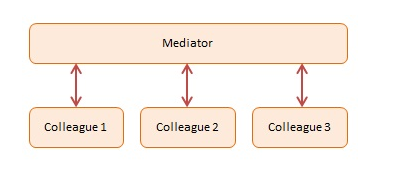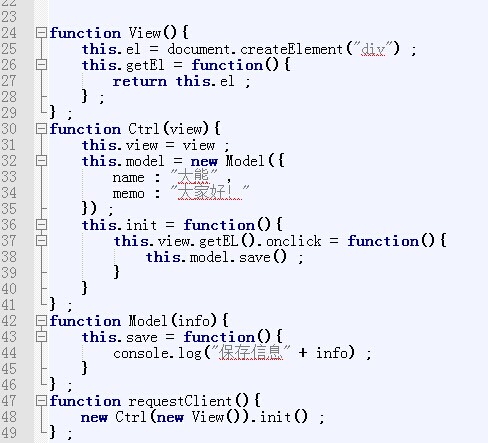1. Overall summary
1, the author briefly discusses
Let’s take a simple analogy from daily life. We go to a housing agency to rent a house. The housing agency forms an intermediary between the renter and the landlord. A renter doesn't care whose house he rents from. Nor does the landlord care who he rents to. Because of the existence of intermediaries, this transaction has become so convenient.
In the process of software development, you will inevitably encounter a situation where multiple classes or subsystems interact with each other, and the interaction is very cumbersome, resulting in each class having to know the classes it needs to interact with, so that their The coupling will appear to be extremely powerful. If one move affects the whole body, the consequences will be serious. The bear will be very angry! ~~~~(>_<)~~~~
Okay, now that the question has been raised, let’s invite our protagonist in this issue—the intermediary mode

The function of the mediator is to encapsulate the interaction between objects. If the operation of an object will cause changes to other related objects, and the object does not want to handle these relationships by itself, then you can find an intermediary and let it handle these troublesome relationships. Look at the small example below:
var Participant = function(name) {
this.name = name;
this.chatroom = null;
};
Participant.prototype = {
send: function(message, to) {
this.chatroom.send(message, this, to);
},
receive: function(message, from) {
log.add(from.name " to " this.name ": " message);
}
};
var Chatroom = function() {
var participants = {};
return {
register: function(participant) {
participants[participant.name] = participant;
participant.chatroom = this;
},
send: function(message, from, to) {
if (to) {
to.receive(message, from);
} else {
for (key in participants) {
if (participants[key] !== from) {
participants[key].receive(message, from);
}
}
}
}
};
};
var log = (function() {
var log = "";
return {
add: function(msg) { log = msg "n"; },
show: function() { alert(log); log = ""; }
}
})();
function run() {
var yoko = new Participant("Yoko");
var john = new Participant("John");
var paul = new Participant("Paul");
var ringo = new Participant("Ringo");
var chatroom = new Chatroom();
chatroom.register(yoko);
chatroom.register(john);
chatroom.register(paul);
chatroom.register(ringo);
yoko.send("All you need is love.");
yoko.send("I love you John.");
john.send("Hey, no need to broadcast", yoko);
paul.send("Ha, I heard that!");
ringo.send("Paul, what do you think?", paul);
log.show();
}
在示例代码中我们有四个参与者,加入聊天会话通过注册一个聊天室(中介)。每个参与者的参与对象的代表。参与者相互发送消息和聊天室的处理路由。
这里的聊天室对象就起到了中介的作用,协调其他的对象,进行合理的组织,降低耦合。
二,源码案例参考
我们应该很熟悉MVC三层模型实体模型(Model)、视图表现层(View)还有控制层(Control/Mediator)。
控制层便是位于表现层与模型层之间的中介者。笼统地说MVC也算是中介者模式在框架设计中的一个应用。

三,案例引入
function Player(name) {
this.points = 0;
this.name = name;
}
Player.prototype.play = function () {
this.points = 1;
mediator.played();
};
var scoreboard = {
element:document.getElementById('results'),
update:function (score) {
var i, msg = '';
for (i in score) {
if (score.hasOwnProperty(i)) {
msg = '
' i ': ';
msg = score[i];
msg = '
';
}
}
this.element.innerHTML = msg;
}
};
var mediator = {
players:{},
setup:function () {
var players = this.players;
players.home = new Player('Home');
players.guest = new Player('Guest');
},
played:function () {
var players = this.players,
score = {
Home:players.home.points,
Guest:players.guest.points
};
scoreboard.update(score);
},
keypress:function (e) {
e = e || window.event;
if (e.which === 49) {
mediator.players.home.play();
return;
}
if (e.which === 48) {
mediator.players.guest.play();
return;
}
}
};
mediator.setup();
window.onkeypress = mediator.keypress;
setTimeout(function () {
window.onkeypress = null;
console.log('Game over!');
}, 30000);
四,总结一下
Why Mediator ?
各个对象之间的交互操作非常多,每个对象的行为操作都依赖彼此对方,修改一个对象的行为,同时会涉及到修改很多其他对象的行为,
如果使用Mediator模式,可以使各个对象间的耦合松散,只需关心和 Mediator的关系,使多对多的关系变成了一对多的关系,
可以降低系统的复杂性,提高可修改扩展性。
使用中介者模式的场合
1.一组定义良好的对象,现在要进行复杂的通信。
2.定制一个分布在多个类中的行为,而又不想生成太多的子类。
可以看出,中介对象主要是用来封装行为的,行为的参与者就是那些对象,但是通过中介者,这些对象不用相互知道。(迪米特法则的具体实现)
使用中介者模式的优点:
1.降低了系统对象之间的耦合性,使得对象易于独立的被复用。
2.提高系统的灵活性,使得系统易于扩展和维护。
使用中介者模式的缺点:
中介者模式的缺点是显而易见的,因为这个“中介“承担了较多的责任,所以一旦这个中介对象出现了问题,那么整个系统就会受到重大的影响。







